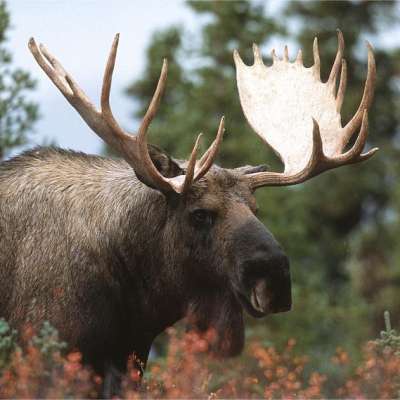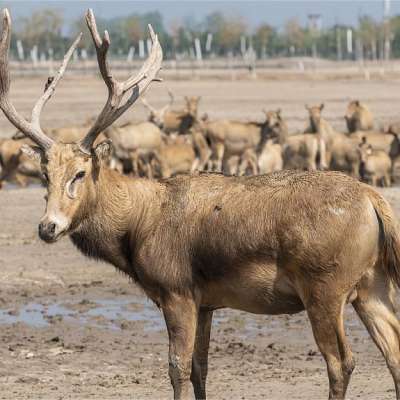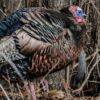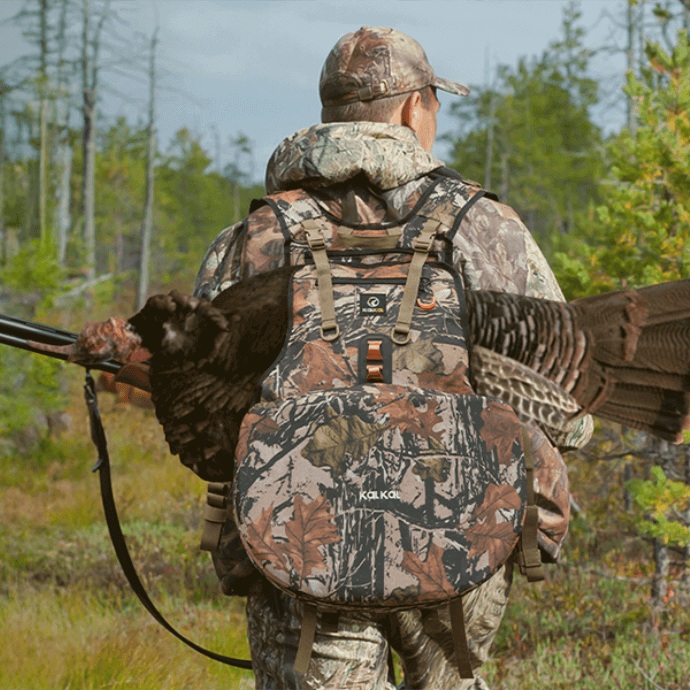Moose vs elk, both belonging to the deer family, share striking similarities, often confusing. Frequently, moose are mistaken for elk due to their comparable herbivorous nature, size, and brown color with imposing antlers.
Despite these resemblances, distinguishing between them is challenging, and several vital disparities exist. Basically, their size differs, and distinctions in antler shapes and nasal features are notable.
Furthermore, the moose exhibits exceptional swimming abilities, can hold its breath underwater, and faces unexpected predators. Even their hoofprints vary, providing a clue to their presence. Let’s learn more about Elk vs Moose.
Elk Vs Moose Overall Comparison
One of the noticeable differences between elk vs moose is their antlers. Male moose have broad, palmate antlers that can span up to 6 feet in width, while male elk have more slender and branched antlers that are typically not as wide as those of a moose.
Moose and elk are types of deer, and in Europe, they call moose “elk.” Moose are way more giant than elk and have broad, flat antlers, while elk have tall, skinny, and branching antlers.
There are different kinds of moose and elk. The Alaska Yukon moose is the biggest deer alive, with males weighing up to a ton! Moose look strange, and elk look majestic, but everyone has their idea of beauty.
In North America, both are significant, impressive animals, but the moose is the biggest deer, darker in color, and has a unique neck flap and a big nose. Elk are lighter, with different antlers and a slender nose. Also, moose like wet, swampy areas, while elk prefer dry forests and grasslands.
This chart shows the difference between Elk vs Moose in a more comprehensive way
| Characteristic | Moose | Elk |
| Size | Much larger | Smaller, second-largest deer species |
| Antlers | Wide, flat, palmated | Tall, skinny, branching |
| Subspecies | Various | Various |
| Largest Extant Cervid | Alaska Yukon Moose (Males up to a ton) | / |
| Appearance | Unusual-looking | Majestic-looking |
| Color | Darker | Lighter |
| Distinctive Features | Neck “bell” and bulbous nose | Different antler shape, slender nose |
| Preferred Habitat | Wet, swampy areas | Dry forests, open grasslands |
Elk vs Moose: Unique Characteristic Comparison
It‘s Probing the differences between elk and moose closely, traits that make each animal unique.
1. Elk vs Moose Size
Elk: Generally small, standing an average of 4.5 to 5 feet at the shoulder.
Moose: Much larger, with an average shoulder length of 5.6 to 6.6 feet.
2. Elk vs Moose Horn
Elk: Forked horns are fitted with rows of teeth, adding to their appearance and size.
Moose: Broad tusk horns with few teeth, giving them a distinctive, flat appearance.
3. Elk vs Moose Panels
Elk: The dorsal lines are thin and rounded, indicating small size.
Moose: Leave out the large, curved footprints for size.
4. Elk vs Moose Sounds
Elk: They communicate through bugles, vultures, and grunts, especially during mating season.
Moose: Songs include deep grunts, bellows, and moans, which serve social and territorial purposes.
5. Elk vs Moose Fur Collar
Elk: Display tawny or light brown coats, which provide excellent camouflage in their woodland habitats.
Moose: Display dark brown fur, generally light hair, and a prominent hump on the back.
6. Elk vs Moose Favorite Food
Elk: primarily graze in grasses and trees and browse tree roots.
Moose: Eat aquatic plants, twigs, and seedlings and prefer a more varied diet.
8. Elk Poop vs Moose Poop
Elk: Generally smaller, cylindrical droppings.
Moose: Larger, often more oval-shaped scat.
9. Elk vs Moose Tracks
Elk: Leave more compact hoofprints with a narrower shape.
Moose: Impress larger, splayed tracks due to their significant size.
10. Elk vs Moose Height
Elk: Tend to be shorter, with an average height of 4.5 to 5 feet.
Moose: Tower over elk, reaching heights of 5.6 to 6.6 feet.
11. Elk vs Moose Antlers
Elk: Antlers are tall, thin, and branched, often with numerous points.
Moose: Possess broader, palmate antlers with fewer points.
12. Elk vs Moose Fur Color
Elk: Display a lighter, tawny, or brownish coat for effective camouflage.
Moose: Exhibit a darker brown fur color with a distinct hump on their lower back.
13. Elk vs Moose Dietary Preferences
Elk: Prefer grazing on grasses, shrubs, and bark.
Moose: Herbivorous, which includes aquatic plant life, twigs, and bark.
Understanding those differences in poop, tracks, peaks, sounds, antlers, fur color, and dietary preferences helps in distinguishing between elk and moose in their herbal habitats. It offers a broader know-how of distinguishing elk and moose traits, striking individuals of the deer’s family.
Elk Vs Moose: Habitat and Distribution
The Elk
- Regions and Habitats: Elk, additionally known as wapiti, are observed in numerous habitats across North America, Central Asia, and Eastern Asia. In North America, they inhabit numerous ecosystems, which include forests, grasslands, and mountains.
- Preferred Environment: Elk decide on open woodlands, coniferous forests, and meadows. They are adaptable and thrive in numerous altitudes, from low valleys to better mountainous areas. They frequently search for regions with ample flora for grazing and get access to water resources.
Moose
- Regions and Habitats: Moose are local to North America, Europe, and Asia. They may be observed in areas with boreal and mixed forests and near lakes and wetlands in North America.
- Preferred Environment: Moose thrive in moist, swampy regions such as marshes, ponds, and lakeshores. They are appropriately adapted to cold climates and are regularly associated with dense vegetation. Moose are brilliant swimmers and are known to browse aquatic plant life.
Understanding their excellent habitat choices is crucial for each elk and moose’s natural world conservation and control efforts.
How To Identify An Elk Or A Moose?
Elk and moose have numerous similarities due to both being giant mammals. They each have antlers that shed yearly, are herbivores, and are typically searched for their meat.
Additionally, they may be observed in similar habitats and have similar tracks, even though moose tracks are more profound and have an extra coronary heart-shaped appearance, at the same time as elk tracks are shallower and enamel-shaped look.
Here are some of the key Identifications:
1. Size
Elk is Generally smaller, with a height ranging from 4.5 to 5 feet at the shoulder.
Moose is Significantly larger, towering over elk, with an average shoulder height of 5.6 to 6.6 feet.
2. Antlers
Elk Antlers are tall, thin, and branched, often with numerous points.
Moose Possess broad, palmate antlers with fewer points, creating a distinctive flattened appearance.
3. Coloration
Elks tend to be most apt at camouflaging themselves due to their lighter coats, which are tawny or brownish.
Moose are darker brown and have a paler mane with an apparent hump on the back.
4. Distinctive Features
Elk Smaller, narrower pointed nose and a less massive corpulence.
Moose have a Bulky nose, peculiar neck flaps or bells, and a greater body mass.
5. Habitat
Elk occur in diverse habitats, such as open woodlands, coniferous forests, and meadows.
Moose Prosper in damp swamps like marshes, ponds, and lake shorelines, often at the edge of boreal or temperate mixed forests.
6. Tracks
Elk Makes more condensed hoof prints with a slimmer shape.
Moose Making large, splayed tracks because of how big they are.
7. Sounds
Elk is Characterized by bugles and barks, particularly while mating.
Moose Communicate through the grunts, some bellowing or moaning as they are bigger.
Knowing these crucial features may assist in determining if you are dealing with an elk or a moose when watching them live.
Tips For Elk And Moose Hunting
How to Elk Hunting
1. Scouting
Before leaving for the quest, do thorough scouting to locate elk populations, their feeding regions, and migration routes. Understanding their behavior is essential for a successful hunt.
2. Learn Elk Behavior
Study elk behavior, especially during mating season. Familiarize yourself with their vocalizations, as bugling can assist in finding bulls.
3. Select the Right Weapon
Choose an appropriate firearm or bow with ok range and preventing energy for elk, considering the numerous terrains where they may be encountered.
4. Clothing and Scent Control
Pay interest to wind course and use scent-manage measures to limit your smell. Elk have an eager feel of smell.
5. Hunt inside the Early Morning and Late Evening
Elk are lively at some stage in those times, making it best for searching. Focus on their natural styles.
How to Moose Hunting
1. Understanding Moose Habitat
Moose decides on wet, swampy regions. Locate areas with considerable plants and water sources.
2. Use Calls Effectively
Learn to mimic moose calls to draw them. Bull grunts and cow calls can be specifically powerful for the duration of the rut season.
3. Be Patient
Moose hunting may additionally require more remarkable persistence. Allow time for the moose to return to you, mainly during the rutting season.
4. Choose Appropriate Caliber
Moose are giant animals, so use a rifle with sufficient quality and bullet weight for an ethical kill.
5. Terrain Considerations
Be prepared for rugged terrain, as moose can be determined in dense forests and close to our bodies of water. Plan your technique, though.
Common Considerations For Hunting
1. Safety First
Prioritize protection by using sporting appropriate equipment, adhering to firearm safety guidelines, and informing others of your hunting plans.
2. Legal Regulations
Ensure compliance with hunting rules, obtain the essential licenses, and adhere to bag limits and hunting seasons.
3. Ethical Hunting Practices
Emphasize moral looking, aiming for clean and humane kills. Respect the animals and their environment.
Even though there are standard searching techniques, such as understanding the animal’s conduct and complying with rules, particular issues for elk and moose searching stem from their extraordinary habitats, behaviors, and sizes. Adapt your method for an extra successful and accountable-looking revel in.
Hunting Regulations For Elk and Moose In Different Regions
The hunting regulations for elk and moose vary across regions, reflecting the diverse habitats and geographical ranges where these animals are found.
Differences in hunting regulations include varying season dates, availability of special permits and licenses, specific regulations for different hunting districts, and requirements for hunting on private property. For example, in Montana, the general season for elk is April 1, while the general season for moose is May 1.
Additionally, the availability of special limited permits and licenses for elk vs moose hunting depends on the hunting district and the type of equipment used, such as rifle or archery.
It is also essential for hunters to distinguish between elk, moose, and other species to avoid accidentally shooting the wrong animal. These regulations are in place to manage and conserve elk and moose populations while ensuring sustainable hunting practices.
Conclusion
When differentiating between elk vs moose hunting, you must identify each species’ unique qualities.
When we begin the journey of chasing elk vs moose, let’s incorporate conservation within our story. Ethical behavior, the preservation of habitats, and a deep commitment to interconnectedness in ecosystems will enhance our outdoor pursuits. Responsible hunting is more than a sport; it’s the preservation of these magnificent creatures as well as protecting our natural resources.
Encourage wildlife conservation projects, participate in hunting training, and promote ethical conduct. It ensures that the wilderness is a refuge for animals and those who appreciate its beauty. Let us stand together as stewards of the wilderness, protecting a tradition that allows our progenies to enjoy elk and moose in their authentic habitats.























Leave a reply